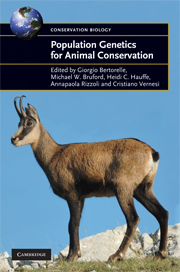Book contents
- Frontmatter
- Epigraph
- Contents
- List of contributors
- Foreword
- Acknowledgements
- 1 Introduction
- Statistical approaches, data analysis and inference
- Molecular approaches and applications
- 6 Challenges in assessing adaptive genetic diversity: overview of methods and empirical illustrations
- 7 Monitoring and detecting translocations using genetic data
- 8 Non-invasive genetic analysis in conservation
- 9 The role of ancient DNA in conservation biology
- From genetic data to practical management: issues and case studies
- Future directions in conservation genetics
- Software index
- Species index (common name)
- Species index (Latin name)
- Subject index
7 - Monitoring and detecting translocations using genetic data
from Molecular approaches and applications
Published online by Cambridge University Press: 05 July 2015
- Frontmatter
- Epigraph
- Contents
- List of contributors
- Foreword
- Acknowledgements
- 1 Introduction
- Statistical approaches, data analysis and inference
- Molecular approaches and applications
- 6 Challenges in assessing adaptive genetic diversity: overview of methods and empirical illustrations
- 7 Monitoring and detecting translocations using genetic data
- 8 Non-invasive genetic analysis in conservation
- 9 The role of ancient DNA in conservation biology
- From genetic data to practical management: issues and case studies
- Future directions in conservation genetics
- Software index
- Species index (common name)
- Species index (Latin name)
- Subject index
Summary
Restocking is a common procedure for artificially increasing the population size of fish and game species in a particular geographical area. A similar intervention, which entails the (re)introduction of individuals from a source population (natural or captive) to a target area, is an important tool for ecosystem restoration, and is often essential to the recovery or rescue of endangered species or populations (Griffith et al. 1989; Frankham et al. 2002). In both cases, the principal aim of these so-called translocations is to establish stable and self-sustaining populations, taking care to preserve the original genetic structure and ecosystem dynamics of the particular species, while avoiding interference with natural evolutionary processes. But how can this goal be achieved in practice?
From an evolutionary and genetic perspective, these primary goals can be said to be attained when the introduced animals are successfully reproducing in the target environment, when negative selection pressures due to the effects of inbreeding or out-breeding depression are negligible, and when evolutionary potential is maintained (Moritz 1999; Frankham et al. 2002; Hufford and Mazer 2003; Tallmon et al. 2004). The challenge is to develop specific translocation plans which guarantee the achievement of all these objectives, and monitor the success of their implementation. For example, selecting animals or groups of animals appropriately adapted to a target environment is only possible by conducting a costly and long-term preliminary phase of fitness analysis. Similarly, the effects of inbreeding or out-breeding depression on the fitness of individuals in a translocated population can go undetected for extended periods of time. As this chapter will discuss, one solution to this dilemma is offered by the analysis of genetic markers; in fact, theoretical population and evolutionary genetics, together with empirical evidence suggest that levels and patterns of genetic variation within and between groups can be used, integrated with ecological studies, to plan and monitor translocations.
- Type
- Chapter
- Information
- Population Genetics for Animal Conservation , pp. 148 - 166Publisher: Cambridge University PressPrint publication year: 2009
- 3
- Cited by



